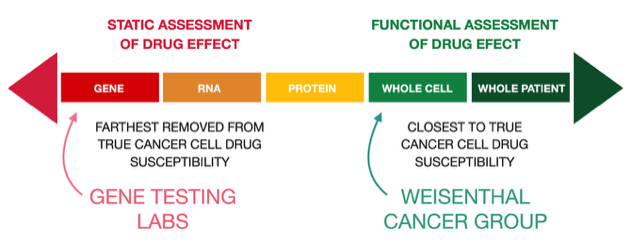

WHOLE-CELL TESTING
(THE WEISENTHAL METHOD)
WHOLE PATIENT TESTING
PROTEIN TESTING
Cytometric Profiling is More Direct and More Clinically Relevant than Genetic Testing
RNA TESTING
MOLECULAR DNA TESTING
(GENOMIC TESTING)

This is the way most treatment is administered today. The idea is to choose a few drugs from among a much larger number of drugs that worked for some patients in various clinical trials conducted in the past. Then you simply administer those drugs to the patient and see what happens. In effect, each patient becomes his or her own medical experiment. If the drug does not work, the patient needlessly suffers harmful side-effects, valuable treatment time is lost, unnecessary costs are incurred, and the surviving tumor cells can become more resistant.
This is Precision Functional Cancer Profiling as provided by Dr. Weisenthal. It is the second most direct method and also the smartest approach. Choose the widest range of FDA approved drugs with known ability to kill cancer cells within a certain cancer type and expose each patient's own, living cancer cells to each drug under consideration. The whole-cell testing method is functional. It measures the ability of each chemotherapy drug to actually kill each patient’s own, living cancer cells. Moreover, because it tests drug effects in real time, whole-cell (cytometric) testing accounts for the fullest possible range of both known and unknown genomic, chemical, and mechanical interactions that govern tumor cell behaviors, including susceptibility to treatment.
Proteins are chemicals that govern cell behaviors, such as susceptibility or resistance to specific chemotherapy drugs. Tests can detect the presence of specific proteins, some of which are targets of therapy or are believed to influence treatment in some way. Protein testing is more direct than RNA testing (below) because it reveals whether or not a protein that, in theory, was encoded-for by DNA actually was produced - but it is a less direct method than Precision Functional Cancer Profiling (the Weisenthal Cancer Group method). Drawbacks of protein testing include 1.) the fact that not all proteins involved in response to treatment have been identified, 2.) only a small number of known proteins are tested, and, 3.) without additional types of testing, there is no way to tell if a protein is functional or, if so, how it interacts with other proteins of known and unknown function.
RNA carries the “blueprint” for production of proteins. Tests exist that can detect the presence of specific types of RNA. It is a more direct method than testing the DNA (below) because it shows that certain genetic information residing in the DNA actually results in production of messenger RNA. However, the presence of RNA implies but does not prove that proteins were produced.
This is genomic testing. It is the least direct testing method because it is farthest removed from what actually happens to the living cancer cell of an individual. DNA contains genetic information that influences normal and tumor cell behavior. DNA encodes for RNA which encodes for production of proteins. DNA is the farthest upstream factor predisposing a theoretical event occurring far at the other end of a highly complex process. Even if all genetic factors were understood, which they are not, the mere presence of a DNA sequence does not mean that the downstream event will occur. If a specific drug targets only a specific DNA sequence, the absence of that sequence might preclude the use of that drug. However, even if the sequence is present, it is still impossible to know if the drug will work. No DNA test (also called a Genomic Test) can pinpoint specific drugs in the same class or detect synergy in drug combinations. DNA tests involve only tiny fragments of dead cells. The entire living cell is NOT tested. In fact, in genomic tests patients’ tumor cells are never exposed to even a single anti-cancer drug.
